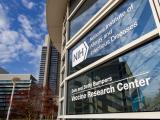Jun 28, 2010 (CIDRAP News) – The US Food and Drug Administration (FDA) today released draft guidance to help reduce resistance to antibiotics used to treat humans—such as penicillin, tetracycline, and macrolides—with more careful use of the drugs in food-producing animals
The agency seeks stakeholder input to help plan its next steps.
At a news conference today, Joshua Sharfstein, MD, the FDA's principal deputy commissioner, told reporters that overuse of antibiotics in food-producing animals is a component of the multidrug-resistant pathogen threat that has also emerged through injudicious use of antibiotics in humans.
He said today's draft guidance summarizes the most recent reports on antibiotic use in food animals and the FDA's view that limiting use in animals is critical to human health. Sharfstein said the proposed guidance is designed be feasible to livestock and poultry producers and address the health needs of animals. The FDA published a notice about the guidance in today's Federal Register and is eager to hear feedback from stakeholders within the next 60 days.
Today's guidance isn't a rulemaking document and doesn't contain proposed legislation, but rather is a statement explaining the FDA's approach to the problem, he said. "This establishes basic principles that could influence the regulatory approach," Sharfstein said.
The FDA is open to what the industry could do voluntarily, he said. "We're not handcuffed to the wheel of a specific strategy at this point, but we're not ruling anything out."
Bernadette Dunham, DVM, PhD, director for the FDA's Center for Veterinary Medicine, said levels of antibiotic use in food-producing animals has been debated for a long time, "by smart and passionate people on all sides." She said some antibiotics that are important for the treatment of human infections have been used not only to treat animals that are legitimately sick, but also to promote animal growth and reduce feed intake.
In a press release today, the FDA said it acknowledges the efforts of various veterinary and industry groups to institute judicious guidelines for antimicrobial use in food animals, but the agency believes additional steps are needed.
"The FDA recognizes the importance of antimicrobial drugs for addressing the health needs of animals. Antimicrobial drugs have been widely used in human and veterinary medicine for more than 50 years with benefits to both human and animal health," it said. "The development of resistance to these drugs, and the resulting loss of their effectiveness, poses a serious public health threat."
The 19-page draft guidance report focuses on two principles: limiting antimicrobial drugs in food-producing animals to those are needed to ensure animal health and limiting that use to include veterinary oversight or consultation.
The FDA suggests phased-in measures that reduce microbial selection pressure while still maintaining the availability of the drugs for appropriate use.
In response to the release of the FDA's guidance, the National Pork Producers Council (NPPC), based in Washington, DC, said in a statement that proposals could eliminate or lead to the costly review of previously approved animal health products, and the recommendations don't appear to be based on science.
NPPC president Sam Carney said in the statement that the proposals, if they eliminate certain antibiotics, could negatively affect animal health and food safety. "As we know, healthy animals produce safe food, and we need every available tool to protect animal health," he said.
The NPPC also raised issues with the proposal to add more veterinary oversight to antibiotic use in animals, pointing out that while it supports medically supervised use, the nation has a widespread shortage of large-animal veterinarians.
Carney added that the NPPC has programs to educate producers about responsible antibiotic use.
See also:
Jun 28 FDA press release
FDA draft guidance
Jun 28 NPPC press release





















